BBC News, Glastonbury Festival
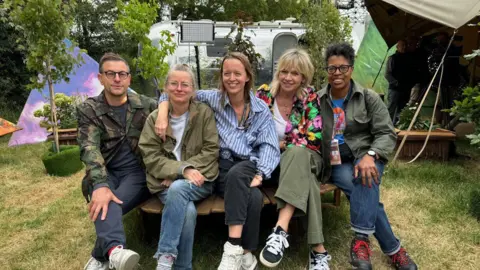 BBC
BBCMore than 90 hours of live streamed performances with coverage across TV, radio, iPlayer, online and social media… all from a dairy farm in Somerset. It can only be the BBC at Glastonbury Festival.
“All we’re ever trying to do is just offer the best seat in the house.”
Alison Howe is executive producer at BBC Studios for Glastonbury on TV and will oversee the BBC television coverage of one of the world’s most anticipated festivals.
This year’s event returns with headliners including The 1975, Neil Young and Olivia Rodrigo, alongside a list of much-loved names such as Charli XCX, Alanis Morissette, Rod Stewart, and many more.
“It’s such a beautiful mix of different types of artists which I think could only genuinely exist in BBC coverage,” Alison said.
“It’s sort of in our DNA as it were, as public service broadcasters.
“The BBC wants to offer the big moments for everyone to watch, but equally it’s a huge supporter of all types of live music, brand new artists, artists of all genres, global artists, and that’s what Glastonbury does brilliantly.”
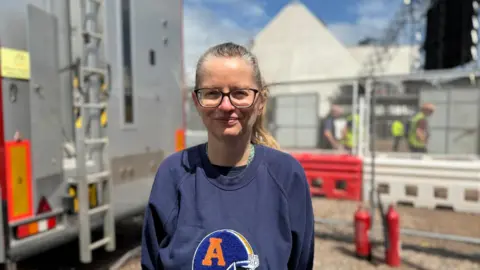
Coverage of Glastonbury is one of the biggest jewels in the BBC’s pop crown, and a record-breaking 23.1 million people watched the festival on TV in 2023.
This year, the BBC said it would make it easier than ever for fans to access the event’s standout moments.
Jonathan Rothery, head of BBC Popular Music TV, said Glastonbury “is the gold standard of pop, comparable to what Wimbledon is to tennis, and the World Cup is to football”.
Alison and her team are very aware of the importance of their role and what it means to the millions of people watching at home.
“It’s incredibly important to put live music centre stage,” she said.
“It’s so much a part of people’s lives these days, music and how they use it for well-being and good memories,” she added.
Alison said one of the “great joys” of being able to cover the festival was “putting an artist who would never normally be on TV in the early evening to find a new audience”.
“It’s just such a simple but very sweet result of what we do.
“For us to be able to share so many brilliant artists, in such a unique place… it gives that sense of almost escapism for a few days, and we do our best to convey every bit of that magic,” she said.
Alison first worked for the BBC at Glastonbury in 1992, when the festival was only covered on radio.
A couple of years later, Channel 4 provided television coverage, before the BBC brought in its cameras in 1997.
“The festival has grown every year and the BBC coverage has grown every year, so it’s been a beautiful sort of synchronised collective journey,” Alison said.
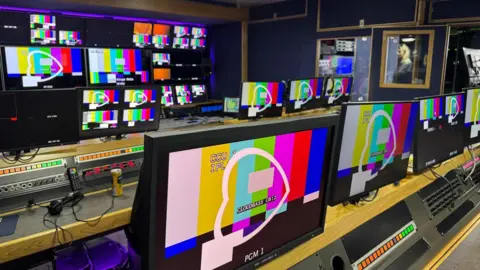
Over the past 30 years, Alison said the biggest change – perhaps obviously – has been technology, but it is this which has transformed the coverage the BBC can deliver.
“When we go back to 1997 and that iconic performance by Radiohead, that wasn’t the live streamed thing that we think of as the norm today,” she said.
“The TV coverage came to it sort of halfway through the set, and all the coverage was very much a late night thing.
“And then you get into the 2000s and the digital TV channels come on board and suddenly there’s more opportunity to broaden the coverage out and appeal to different audiences and have different tones of presentation.
“Now we’ve got the iPlayer and streaming and the chance for people to catch up on content, so the way people are watching and listening has changed, and the coverage has adapted to suit that.”
But broadcasting such a spectacle is not just a case of turning up weeks before the festival, especially when you are dealing with some of the biggest artists in the world.
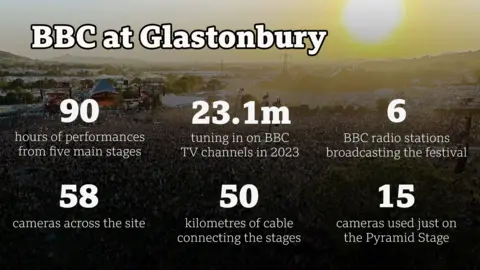
Peter Taylor, head of operations for BBC Studios, co-ordinates the technical facilities for the TV broadcasts and live stage coverage.
He said a lot of planning went into making sure the team knew what the aim was for the programme, as well as discussions with artists’ production teams to know what might appear on stage.
“I then work with our camera, sound and vision teams to ensure we have the right kit and connectivity to be able to capture the spectacle,” he said.
The physical side of broadcasting such a huge operation starts two weeks before the first artists take to the stage.
The foundations are a temporary trackway, power distribution, office cabins and other basic facilities. The technology arriving gets more complicated as the days go by, with the big outside broadcast trucks arriving on the Tuesday of festival week.
“We really only have two days to rig all the cameras, sound feeds, signal distribution and radio camera kit before we are on air on Thursday night,” Peter said.
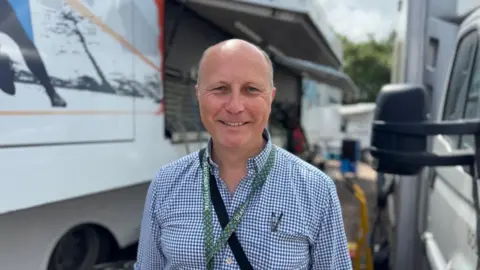
“It is an intense period of work and is over far too quickly as the festival whizzes by,” he added.
But Peter said the biggest challenge was “the scale of the site as well as the scale of the coverage we try to deliver”.
While there are bigger events broadcast by the BBC – such as the Olympics – Peter said the Glastonbury team delivered “a similar number of hours of complex broadcasts, and have the added challenge of trying to match the creative ambition of the artists on stage, all potentially while wearing wellies”.
He said the team had built up a strong relationship of trust with the festival’s production staff on site, while Alison put year-round relationships with top performers central to delivering a spectacular show.
“If you’ve worked with particular artists through Later with Jools Holland or BBC Radio shows… then when they come to have a big moment at Glastonbury, that relationship is there, that trust is there, because ultimately they put their show in our hands,” she said.

This is helped by the BBC’s line-up of presenters, with this year’s coverage seeing the likes of Jo Whiley, Zoe Ball, Lauren Laverne, Nick Grimshaw, Clara Amfo, Greg James, and many more hosting.
BBC iPlayer is being touted as “the ultimate place to watch Glastonbury”, bringing viewers more than 90 hours of performances with its live streams of the five main stages – Pyramid, Other, West Holts, Woodsies and The Park.
The Glastonbury Hits Channel has been live since early June, while The Glastonbury Channel returns later on Friday.
On TV, there will be extensive coverage on BBC One, Two and Four, while radio teams from six BBC radio networks will be providing hours of live coverage with more available on BBC Sounds.
‘A unique island’
This year the BBC is also introducing audio description for coverage on BBC One, while Jonathan said they were also “really proud that Pyramid Stage sets will be streamed live in British Sign Language for the third year”.
And doing all of that from a field in Somerset adds another level of expertise.
“It’s that beautiful mix of feeling like you’ve just been transported to this sort of unique island, this Isle of Avalon, with all these different treats, and then there’s the community spirit of camping and the weather – good or bad – all that adds to the adventures that it brings,” Alison said.
The festival is on the cusp of a fallow year – when the fields are given the chance to recover. So for all those working for the BBC, Alison says there is “a slight level of wanting to make sure it’s the best it can possibly be”.
“Because when it’s not on, it’s truly missed,” she said.



